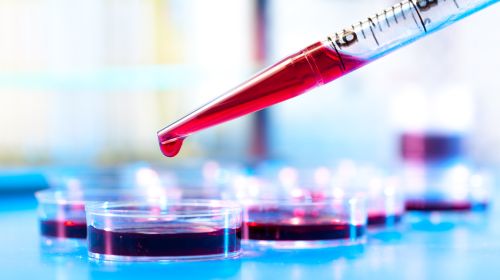In the metabolic disease porphyria, the production of the red blood pigment heme works poorly. This causes sudden severe abdominal pain, an increase in blood pressure, confusion or skin discomfort. With good treatment, further attacks can usually be prevented.
- With porphyria, violent, cramp-like abdominal pain often sets in suddenly.
- © PeopleImages via Getty Images
Porphyria is a very rare congenital metabolic disease. Certain enzymes (proteins) do not work properly and are therefore unable to produce enough heme. However, heme is critical to making red blood cells (hemoglobin), which carry oxygen in the bloodstream. Depending on where the defect occurs in the heme production, a distinction is made between several forms of the disease, some of which have their own symptoms.
At a glance:
Forms of porphyria
Acute forms of porphyria suddenly appear:
- Acute intermittent porpyhria (AIP) – by far the most common form
- Porphyria variegata (PV)
- Hereditary coproporphyria (HKP)
- Delta ALA dehydratase deficiency porphyria (Doss porphyria) – very rare
The non-acute forms of porphyria are associated with long-term symptoms, usually on the skin:
- Porphyria cutanea tarda
- Erythropoietic protoporphyria
- Congenital erythropoietic porphyria (Günther's disease) – very rare
Since no heme can be formed due to the defect in the enzymes, an excessive number of precursors of heme accumulate in the body. Some of these are deposited in the liver, bone marrow or skin. This then results in the complaints. At the same time, there is a lack of red blood cells for oxygen transport. Because of the different symptoms associated with many diseases and the rare occurrence of porphyria, the disease is often diagnosed late. The symptoms vary from slightly disturbing to life-threatening.
Causes: This triggers porphyria
Porphyria is based on an inherited genetic defect. However, there are also many people for whom this genetic defect does not cause problems. The body manages to compensate for the defect. Usually it is further (external) influences that lead to the appearance of the symptoms. If, for example, high alcohol consumption or the use of medication put additional strain on the liver, the heme precursors in the blood and liver cause symptoms. The female cycle or infections can also trigger a surge.
Typical triggers for an acute attack of porphyria:
In Europe, around one in 75,000 people per year has an acute episode of porphyry. Since, according to an analysis of French blood donors, about one in 1,700 people has the genetic make-up for it, only a very small proportion of those genetically affected actually get it. Three quarters of those affected are women. The disease is usually noticed in young adulthood, between 20 and 40 years of age.
Porphyria cutanea tarda, on the other hand, occurs a little later and is usually only visible after heavy alcohol consumption. Men develop this form of porphyria twice as often as women, around one in 25,000 people annually. Often those affected had previously had hepatitis C or took estrogens. Lead poisoning can also lead to porphyria.
Symptoms of acute porphyria and porphyria cutanea tarda
In acute porphyria, severe, cramp-like bulging pain that begins suddenly is typical. In addition, there are often nausea and vomiting as well as palpitations and increased blood pressure. Neurological abnormalities such as abnormal sensations, muscle weakness or paralysis are also common, as are confusion, fears or even hallucinations. In extreme cases, the symptoms can even be life-threatening.
Porphyria cutanea tarda (“late porphyria of the skin”), on the other hand, is particularly evident on the skin: skin vesicles quickly form on the face, neck and hands when exposed to sunlight / UV light. These occur even with the smallest injuries in everyday life. That is why those affected are disfigured by many tiny scars, which are often accompanied by small white spots (milia). Many of them also have tiny hairs growing on their foreheads and cheeks. The urine is often dark in color.
The less common forms of acute porphyria variegata and hereditary coproporphyria also often show vesicles and small wounds on the skin.
Diagnosis of porphyria
Doctors do not always think of the rare disease porphyria when they have abdominal pain and palpitations or skin problems. For diagnostics, it is important to examine the urine for the two porphyrin precursors porphobilinogen (PBG) and 5-aminolevulinic acid (5-ALA) during an attack. If elevated concentrations are found, blood and stool should also be tested for porphyrin. In addition, the doctor must check the liver function. Sometimes it is also advisable to rule out viral hepatitis and to check the iron status of the person affected. An increased iron value is a typical sign of porphyria cutanea tarda.
If it is clear after diagnosis that porphyria triggered the symptoms, those affected should inform their relatives. They often suffer from the same genetic defect and can prevent the disease from breaking out by being careful when consuming alcohol and taking medication.
Porphyria: Treatment with heme arginate
However, the most important treatment for an acute episode of porphyria is an infusion of heme arginate. This gives the body the heme it needs and therefore reduces the formation of harmful heme precursors. If the drug is not immediately available, an infusion of glucose can also help, which dilutes the concentration of the heme precursor in the blood. Certain medications can be used against high blood pressure or pain, which do not further intensify the porphyria attack.
With porphyria cutanea tarda, targeted sun protection is particularly helpful: those affected should avoid direct sunlight and wear long-sleeved clothing, closed shoes and wide-brimmed hats. Uncovered areas of skin should be protected with reflective sunscreens such as zinc oxide or titanium oxide. In addition, blood is often drawn from those affected to reduce the level of iron in the blood. The drug chloroquine also helps some sick people. In contrast to the acute forms of porphyria, medication in porphyria cutanea tarda does not normally increase the symptoms.
This is how you can prevent porphyria
Anyone who knows that they have porphyria or the corresponding genetic defect should refrain from alcohol and diets. When taking medication, those affected should discuss with the doctor whether the medicine is unavoidable and whether there are alternatives that are better tolerated by the sick. Anyone suffering from an acute attack of porphyria should try to continue eating as normally as possible, especially carbohydrates. If a certain drug is the trigger, it should be discontinued as far as possible.
Avoid triggers
In most people with acute intermittent porphyria, all symptoms go away after treatment of the attack. If you avoid the triggers from now on, those affected can live carefree. However, some people, especially women, develop a chronic form. With them the symptoms recur regularly, often with the monthly cycle. In severe cases, therapy with pain specialists is recommended.
Anyone who knows that they have a porphyria gene defect should behave accordingly carefully. A flare-up can usually be prevented with a few simple precautions:
- Refraining from alcohol consumption
- Be careful when taking medication
- Contraception without hormones
- Even carbohydrate intake
- Protection from the sun (with Porphyria cutanea tarda)
Affected parents can have their children tested for the genetic defect. Your risk of inheriting the genetic defect is around 50 percent. Those who stick to the precautionary measures often do not even notice their porphyria.


